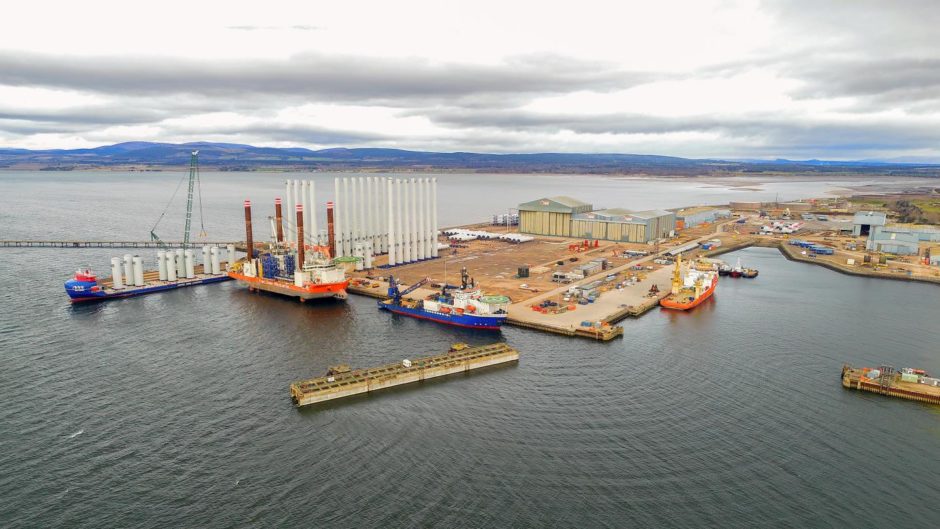
In the Scottish Highlands, discussions are currently ongoing that could transform the region into the world’s next energy and maritime hotspot.
Global Energy Group (GEG) is exploring using land at Port of Nigg, near Inverness, to establish a colossal power-to-X (P2X) project that could revolutionise the way the harbour, and the region, operates.
P2X has been described as the “energy storage and sector coupling technology” of the future.
The process involves converting renewable energy into carbon neutral fuels, such as hydrogen, ammonia and methanol.
They can then be phased into the energy system as a direct, green replacement for conventional oil and gas.
Tim Cornelius, GEG’s chief executive, said the facility, which would have a “very large capex”, has the potential to “dwarf” all its other ongoing projects.
He said: “We are looking at the opportunity to use some of the real estate we control to establish a huge P2X project. That would allow us to look at different forms of molecules that have different values, rather than just electricity.
“One area being looked at is the booming market that exists, specifically in marine transport, for methanol and ammonia production. That would require green hydrogen and therefore we’re in the preliminary stages of looking at the feasibility of using areas of our land to establish a large methanol, ammonia, or liquefied project.
“That would require us to generate a substantial amount of hydrogen on site – there are no large industrial sources in close proximity to Nigg. We’d need a large bank of electrolysers. More than 100 megawatts. That would make it an incredibly large project in the context of what’s ongoing in the UK.
“The process of moving hydrogen into a more valuable molecule like methanol requires CO2 so we’re currently looking to use either offshore sources of CO2 or tying into local distilleries, which produce a very pure form of CO2.”
As well as its P2X feasibility study, GEG is currently engaged in a study with Scottish Power in relation to “establishing hydrogen generation facilities” in or around Nigg.
Cornelius said: “The hydrogen piece is important but more than anything it’s about the renewables that’ll be required to power our operations.
“There’s obviously potential for building a tower rolling facility at Nigg and we want to make that as carbon neutral as possible. It will also give us a green power source for all the logistical vehicles that are required to support our operations – that would really improve our credentials.”
He added: “It’s been driven by the customers. It’s one thing to obviously purport that you’re getting behind decarbonisation, but if you’re not doing it in your own facilities then obviously there’s a hypocritical element to the rhetoric.
“We recognise that the first and easiest approach is just to bring more renewables into the site, potentially through a private wire from an offshore wind farm, although our demand, despite being large, isn’t big enough to justify that. But, from a hydrogen perspective, that’s where it starts to become super interesting.”
Port of Nigg, and the Port of Cromarty Firth more widely, is well positioned to be an offtaker of green electricity.
Several large renewables projects, including the Beatrice and Moray East offshore wind farms, are either in operation or in development in relatively close proximity to the port.
And with developers looking for alternatives to feeding their power into the grid, a costly process for remote projects, there is a convenient crossover of interests.
Cornelius said a P2X project is likely to be something that a large renewables developer would be “incredibly interested in”.
However, a large amount of its success hinges on one fundamental thing, which, at this stage, is out of GEG’s hands.
The Scottish Government is in the process of deciding which harbours will be awarded “greenport” status, as part of its efforts to aid the energy transition.
Influence by Westminster’s freeports, designated areas that benefit from fewer regulations and less taxes, the Scottish versions will be given more of a net zero twist.
Harbour owners will benefit from a “streamlined planning process” and “customs reliefs”, designed to give ailing or fledgling regions a shot in the arm.
Port of Cromarty Firth is vying to become one of the initial cohorts of greenports, with bosses at the site previously flagging the negative impact the delay to the process is having on its ability to secure work.
Cornelius labelled greenport status the “number one” thing Nigg needs in order to get its ambitions off the ground.
He said: “The export angle for this hinges on the ability for us to be able to establish Greenport status. The global methanol market, which covers anti-freeze in cars all the way through to marine fuels, is incredibly competitive.
“The fact it is used widely is very advantageous. It means there is already an established market, you can ship it very easily and that’s why you’re seeing a lot of these P2X projects starting to crop up around the world with offshore wind developers. It’s a way to make a higher value product than electricity.
“In the UK, we’d be able to use the substantial amount of offshore wind capacity, a lot of which is going to be built on the back end of ScotWind, as well as new onshore wind projects.
“But, for the UK to competitive against the European market, we need to have that greenport status, otherwise the opportunity will be lost.”
Cornelius is confident though that, with the right policies in place, Port of Nigg can become the UK’s answer to Rotterdam.
He added: “In the UK, we want to be the central cluster, regardless of whether it’s for loading cables, loading out towers, or marshalling. We want to take that the full way up the value chain into energy transition and P2X projects.
“If you add that up, you’re talking about billions of pounds worth of capex being spent and we want to establish ourselves as the as the number one port in the UK for renewables.
“The most interesting thing will be delivering it in a really fast time frame so that we’re able to make sure we can keep the workforce on the books, rather than there being dips in operations between projects.
“We’re talking about employing thousands of people here and they need to know this is coming sooner rather than later so they can commit to this hugely exciting region.”
Recommended for you


